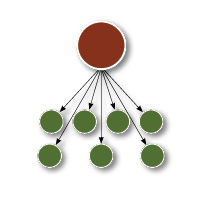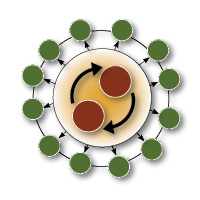Capacity Building—A Mindset Shift
For many people, getting involved in service-learning, civic engagement, community engagement, or other forms of community work comes from a deep motivation and commitment to helping those less fortunate than themselves. This charitable mindset, though laudable in many respects, can be a barrier to real and lasting community change—especially if its focus is mostly on the giver's altruistic feelings and the relief of the sufferer's immediate needs (Munsil, 2003, pg. 8). This charitable mindset also reinforces the relationship between "the haves" and "the have-nots" instead of affirming the idea that all people have important gifts, talents, and capacities to contribute. Very often, community work framed by a charity mindset focuses on immediate solutions over longer-term improvements that create sustained change.
For community work to be sustained in the long term, community partners must be given the opportunity to strengthen their own confidence, increase their own knowledge, build their own skills, and expand their own resources. This alternative approach to community work recognizes the reciprocal and generative nature of collaboration with community partners and focuses on the goal of capacity building for sustained change.
Shift in Whose Knowledge Counts
One of the key features of a capacity building mindset is the shift away from an expert-centered model of community change—one where experts share their knowledge with community partners and tell community partners what to do through a one-way flow of knowledge.
Instead, a capacity building mindset acknowledges and honors community knowledge and results in a more interactive and generative model of community change—one where local people and experts participate in two-way flows of knowledge. This collaborative focus on knowledge-making encourages everyone's contribution to the process. Because local knowledge is incorporated into the decision-making process, culture and context are taken into consideration as alternatives are suggested, leading to choices that are more sustainable in the long term (Pigg & Bradshaw, 2003).

Expert-centered model

Capacity building mindset
Capacity building represents a significant mindset shift about whose knowledge counts, and, as a result, requires different processes of collaboration with community partners.
Starting at the Riverfront Development Organization
Alicia is a senior writing and rhetoric major. During her freshman and sophomore years, she participated in a number of service-learning activities in and out of class. At first, she was a little hesitant about working with community people, but after a while, Alicia had fun getting to know new people. It felt really good to help them out with various writing projects, like press releases, newsletter articles, and webpages. All of those writing samples added a lot to her portfolio.
For her senior capstone class, Alicia made sure she signed up for the section that had a service-learning requirement. On the first day of class she was assigned to the Riverfront Development Organization, a nonprofit group dedicated to making the area along the river clean and friendly to businesses and everyday people. She was super excited and set up a meeting with the executive director of the Riverfront Development Organization for the second week of classes.